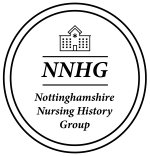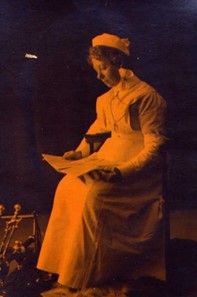Photograph reproduced with permission of Rosalie Maddock-Lyon
Elizabeth Fawcett Ross was born in Hull, Yorkshire on 2 Jan 1867. The family remained in Hull; in 1881 her father was an ironmonger, employing twenty men and boys and Ross was one of seven children. She was educated at Penrhos College, Colwyn Bay.[1]
Ross trained as a nurse at Leeds General Infirmary from 11 February 1891 to 25 March 1894, and undertook her district training as a Queen’s probationer with Bloomsbury district nursing association from 16 August 1894 to 19 February 1895. She was appointed a Queen’s Nurse on 1 July 1895 and was nursing in Handsworth, Birmingham, from 1895 to 31 July 1900.[2]
From September 1900 Ross was an Assistant Superintendent in Northampton. The 1901 census lists her as a Queen’s Nurse on the staff of the ‘Nursing Institution’ (official title ‘The Queen’s Institute of District Nursing’), 31-33 Hazlewood Road, St. Giles, Northampton, where her ‘work and conduct was excellent, suitable for a responsible post’. According to her Queen’s Nurse record she remained there until 31 May 1902, resigning to train as a midwife at Plaistow, London, and achieving her L.O.S. on 28 July 1902. In September of the same year, she received her Queen’s Nursing Institute silver badge.[3] Ross was awarded her Central Midwives Board certificate on 25 February 1904, her name appearing on the Midwives Roll from 1905 to 1926.[4]
Ross was appointed County Superintendent of the Nottinghamshire Federation of District Nursing Associations in September 1902.[5] She was responsible for supervising and inspecting the work of the twenty-five nursing associations affiliated to the Notts Federation at that time.
In 1904 she was appointed Inspector of Midwives for Notts. County Council for twelve months at a salary of £50, in addition to being County Superintendent of the Notts. Federation. In 1902 the registration of Midwives Act was passed and the Central Midwives Board (CMB) was created, leading to the registration of trained midwives, recorded by the CMB on the Midwives Roll. The aims of the act were ‘to secure the better training of midwives and to regulate their practice’; it came into force on 1 April 1903. County and Borough Councils became local supervisory bodies with power to supervise midwives in their areas, reporting to the CMB details of midwives who intended to practise and any contraventions of the Act.[6]
Ross was the first Supervisor of Midwives in Nottinghamshire – a significant first. In 1905 the Nottinghamshire Medical Officer of Health reported that the assistance of Ross had been ‘invaluable’ as inspector of the nursing duties performed by midwives and her efforts to impart information to them at the same time were much appreciated.[7] At that time she was living at 20, Mapperley Road, Nottingham.[8]
Ross took part in the campaign for nurse registration and was a member of the Society for the State Registration of Trained Nurses, attending the Nottingham meetings. [9] She was also one of eighteen high profile signatories to a letter sent to the Morning Post in March 1905, most of whom were matrons from across England. The letter strongly opposed the scheme by a number of laymen to set up an association supervising the education and training of nurses, along with a register of approved nurses and the power to remove names as thought fit, arguing that the control of nurses should be in the hands of professionals, with trained nurses on any governing body.[10] She signed the Nursing Register on 27 October, 1922.
In 1909, as County Superintendent of the Notts. Federation, Ross was described as ‘energetic and most capable, managing the nurses tactfully and well’.[11] She was County Superintendent for over seven years until she became the Queen’s Institute’s Inspector of the Central Counties of England on 7 April 1910.[12] In her new role she paid an inspection visit to Louth District Nursing Association, Lincolnshire on 21 April 1910, expressing much satisfaction with Nurse Dancy’s work.[13] In June, Lady Denison presented her with an address (book) and purse containing twenty-five guineas on behalf of members of the Nottinghamshire Federation, in appreciation of ‘her work and personal worth’.[14]
In 1911, the census recorded her as a Nurse Inspector for Queen Victoria’s Nursing Institute, living in Hull with her widowed mother and twin sister Mary. It appears that she was based there and travelling to the central counties areas to carry out her inspection work. She spoke at a Queen Victoria’s Jubilee Institute conference in London in 1914, at which the principle of co-operation and working together between public authorities and voluntary nursing associations was discussed. She described the combined nursing scheme being considered by the Yorkshire West Riding County Council, expressing the view that this development was generally gaining favour. The objective of this scheme was to combine and ‘utilise all existing agencies and to avoid putting in officials where nurses were already established; also to have efficiency with economy and a minimum amount of travelling for workers’.[15] However, conference speakers also emphasised the difficulties of getting all the bodies involved with public health to work smoothly together.[16]
At the time Ross then lived at 42 Westwood Road, Porter Glen, Sheffield but she had returned to Nottingham by 1915.[17] She is listed in the electoral rolls as living in Nottingham until 1930, firstly at 20 Mapperley Road as in 1904, then at 1, Arboretum Street from 1928.[18] Throughout that time Annie Ross (later Handley) lived with her.
On 15 June 1915, as Queen’s Inspector, she paid a visit to Tamworth District Nursing Association, where she found that ‘the work seen was well and acceptably done, and the equipment was in order’.[19] In 1916 she was awarded a gold and enamel long service badge for twenty-one years’ work as a Queen’s Nurse.[20] In august of the following year, the Inspector’s areas were rearranged by the Queen’s Nursing Institute and Ross became responsible for the North East Midlands.[21]
On 22 December 1920 she was granted two months’ leave for a rest, returning to work on 22 March 1921. In August of that year she was promoted to Senior Inspector and Inspector of County Nursing associations. On 20 March 1927 she was ‘off duty ill’, returning to work on 23 May 1927 but resigned from the Institute on 31 May 1928. She undertook temporary inspection work from 7 June to 15 July 1928, officially retiring on 23 July 1928. She was given a glowing report at the end of her Queen’s Nurse record: ‘Excellent in every way, tactful, capable, most steady and reliable, always willing and kind, sound in judgment, progressive in ideas, devoted to her work, and loved by all.’ [22]
Ross was awarded an annuity of £15 per annum from the Queen’s Nurses Benefit Fund, payable in advance in half yearly instalments of £7 10s in June and December, and an annuity of £85 per annum payable quarterly, starting three months after resignation.[23]
Ross moved to Worthing after she retired, In 1939 she was living with Annie Handley, retired violin teacher, at 41, Highdown Avenue, Worthing and listed as a ‘Retired hospital nurse – trained’. Ross died in Worthing on 15 November 1950, aged eighty-three.
[1] UK & Ireland, Queen’s Nursing Institute Roll of Nurses, 1891-1931
[2] UK & Ireland, Queen’s Nursing Institute Roll of Nurses, 1891-1931
[3] UK & Ireland, Queen’s Nursing Institute Roll of Nurses, 1891-1931
[4] Ancestry.com. UK, The Midwives Roll, 1904-1958
[5] UK & Ireland, Queen’s Nursing Institute Roll of Nurses, 1891-1931
[6] Records of the Central Midwives Board, The National Archives, https://discovery.nationalarchives.gov.uk/details/r/C92
[7] The British Journal of Nursing Volume34 Page 73 28 January 1905
[8] Midwives Roll 1905
[9] The British Journal of Nursing Volume33 Page 430 26 November 1904
[10] Morning Post 6 March 1905
[11] UK & Ireland, Queen’s Nursing Institute Roll of Nurses, 1891-1931
[12] UK & Ireland, Queen’s Nursing Institute Roll of Nurses, 1891-1931
[13] Louth and North Lincolnshire Advertiser 4 June 1910
[14] Nottingham Evening Post 10 June 1910
[15] Sheffield Daily Telegraph 5 March 1914
[16] The British Journal of Nursing Volume 52 Page 229 14 March 1914
[17] The British Journal of Nursing 27 March 1915 Volume 54 Page 254
[18] England & Wales, Electoral Registers 1910-1932
[19] Tamworth Herald 22 April 1916
[20] The British Journal of Nursing 22 July 1916 Volume 57 Page 74
[21] UK & Ireland, Queen’s Nursing Institute Roll of Nurses, 1891-1931
[22] UK & Ireland, Queen’s Nursing Institute Roll of Nurses, 1891-1931
[23] UK & Ireland, Queen’s Nursing Institute Roll of Nurses, 1891-1931

